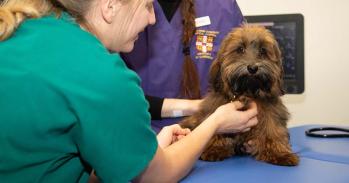
Each year thousands of cattle are slaughtered to control the spread of bovine tuberculosis. New research reveals that testing misses many animals harbouring the disease and shows that large herds are particularly vulnerable to rapid transmission.
Each year thousands of cattle are slaughtered to control the spread of bovine tuberculosis. New research reveals that testing misses many animals harbouring the disease and shows that large herds are particularly vulnerable to rapid transmission.
Around 38 per cent of herds that are cleared experience a recurrent incident within 24 months, suggesting that infection may be persisting within herds.
Dr Andrew Conlan
A team of scientists has used mathematical tools to develop models for estimating the efficiency of cattle-based controls for bovine tuberculosis (bTB). These models will help policy-makers to understand, and thus to control, a disease which costs the UK taxpayer around £91 million per annum for testing, slaughter of animals and compensation to farmers.
The models built by the team represent an advance over previous models as they are informed directly by extensive data on reported incidence and spread of the disease, rather than expert opinion. Importantly, they provide a first estimate of the quantity of infection missed by cattle testing and the contribution of this hidden burden of infection to the persistence of bTB within herds.
Applied to recent data, the models suggest that around one in five of British herds that have been cleared of restrictions, following testing for bTB, may harbour the infection. It also points to a higher incidence, and faster spread, of the disease in large herds.
The Defra-funded research was undertaken by a cross-disciplinary group of experts at the Department of Veterinary Medicine, University of Cambridge, and the Animal Health and Veterinary Agency. It was led by Dr Andrew Conlan, a researcher in Cambridge’s Disease Dynamics Group, who specialises in mathematical modelling and also works on the spread of childhood diseases.
The team’s findings are published today (18 October) in the online journal PLoS Computational Biology. Two contrasting models were used to demonstrate that the efficiency of control is critically dependent on the time between cattle being infected and becoming infectious to other animals.
The research focuses on the cattle-to-cattle transmission of bTB within herds - rather than infection from environmental factors, such as the reservoir of the disease that is known to exist in the badger population.
By concentrating on the processes that occur once infection has arrived in a herd, the study provides a more realistic representation of the complex system of testing than has been possible in larger scale national level models. It points to a high level (up to 21 per cent) of hidden infection in herds that have been passed as TB-free and also strongly suggests that larger herds suffer not just a higher incidence of the disease but also a faster rate of spread between cattle.
“The numbers of cattle herds placed under movement restrictions in Britain due to the suspected presence of bTB has increased progressively over the past 25 years despite an intensive and expensive test-and-slaughter programme. Around 38 per cent of herds that are cleared experience a recurrent incident within 24 months, suggesting that infection may be persisting within herds,” said Dr Conlan.
“bTB represents a real challenge as there are so many factors involved in the transmission of the disease and in the interpretation of testing. The intensity of surveillance in Great Britain means that animals rarely progress to be sick, with the only evidence of disease being a positive result to testing, but this is known to miss some cases. Estimating the hidden burden of infection missed by testing requires mathematical models that account for the balance between the rate of spread of disease and the efficiency of testing.”
Since the 1950s, diagnostic testing has been based on reactivity to tuberculin, administered as an injection into the animal’s skin which responds with a lesion if the animal is positive.
“Many aspects of bTB, and its transmission, remain a mystery – and it’s long been known that the protocol and testing methods used to diagnose the disease are far from perfect. One of our models suggests that up to 21 per cent of herds may be harbouring infection after being cleared from movement restrictions,” said James Wood, Alborada Professor of Equine and Farm Animal Science at Cambridge University.
“However, our models also estimate a high rate of re-introduction of infection into herds, particularly in high incidence areas. This rate of re-infection is high enough that even if improvements in testing eliminated the hidden burden of infection, rates of recurrence would not be reduced.”
bTB can be transmitted from cattle to people in untreated milk, and is a serious health risk. Pasteurisation effectively kills off the bacterium, meaning that treated milk is safe to drink. Stringent measures introduced by the British government from the 1930s onwards – including pasteurisation and childhood vaccination - saw deaths from the disease plummet. Subsequently, a rigorous policy of cattle testing and slaughter saw levels of the disease in herds drop to an all-time low in the 1960s.
But the past 25 years have seen the disease return in cattle with a vengeance with around 26,000 animals slaughtered for TB control in England in 2011 alone. The reasons for this rise, and the best way to control the disease, is hotly debated within the farming and veterinary communities as well as in the public arena.
“Our work quantifies the extent to which deficiencies in testing may be contributing to the continuing bTB epidemic in Great Britain. However, it’s important to note that these models cannot inform the extent to which the hidden burden of infection is contributing to transmission between herds by cattle movement. This aspect of the spread of bTB is being addressed by current research,” said Dr Conlan.
“We hope that our research provides a tool for understanding the efficiency of the control of managed diseases – and can be used as a basis for testing future interventions such as vaccination.”
The research was funded by the Department for Environment Food and Rural Affairs (Defra).
This work is licensed under a Creative Commons Licence. If you use this content on your site please link back to this page.





